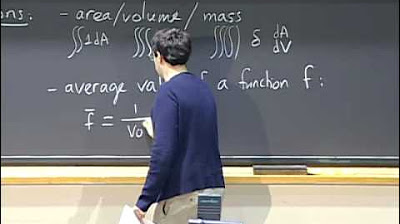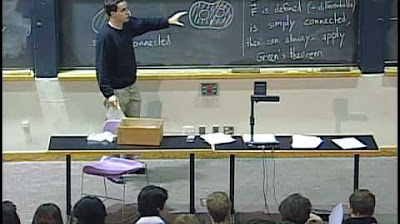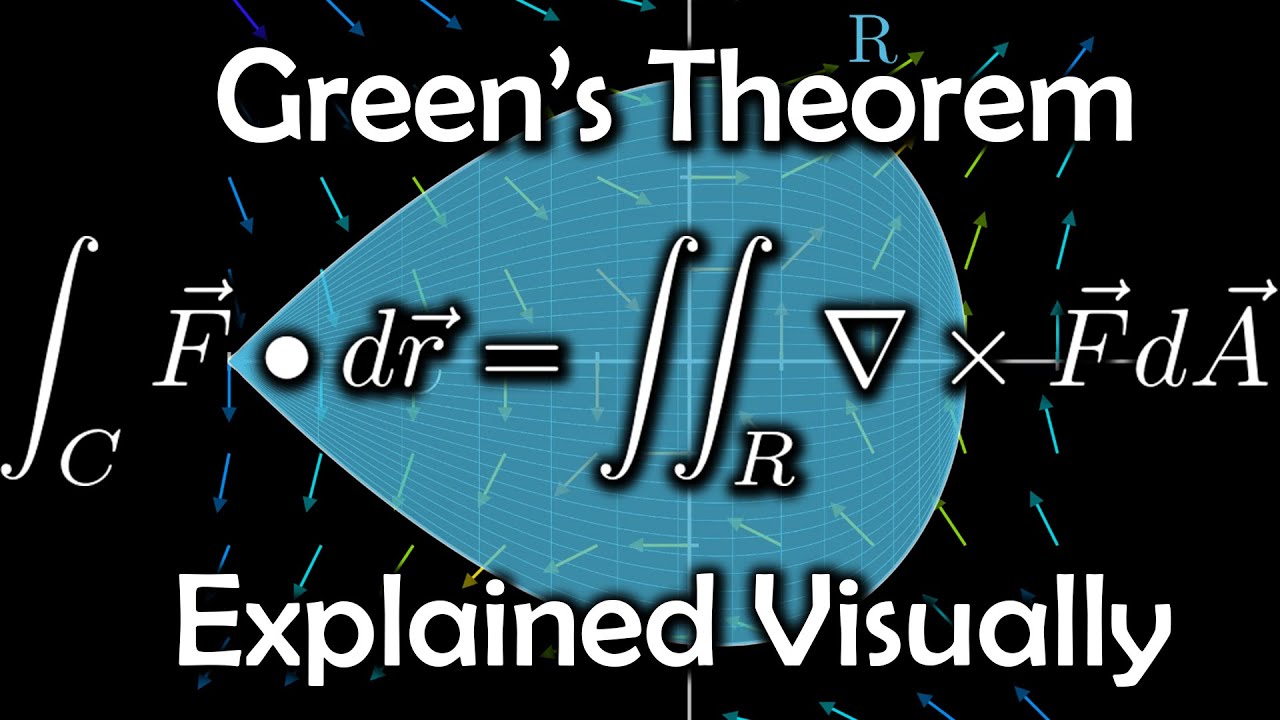Calculus 3 Final Review (Part 3) || Vector Calculus || Line Integrals, Green's and Stokes' Theorem
TLDRThis video script offers an in-depth review of calculus three, focusing on vector calculus, which the narrator considers the most challenging part. It covers line integrals, surface integrals, Green's theorem, Stokes' theorem, and the fundamental theorem for line integrals. The script provides detailed explanations, definitions, and step-by-step examples to clarify these complex topics. It also touches on curl, divergence, and the divergence theorem, aiming to simplify the subject matter for students preparing for their final exams.
Takeaways
- 📚 The video is a calculus three final review focusing on vector calculus, considered the most challenging part of the course.
- 📝 The presenter plans to cover line integrals, surface integrals, Green's theorem, Stokes' theorem, and the fundamental theorem for line integrals.
- 🔍 Line integrals are discussed first, with an explanation that they integrate a 3D curve and can be thought of as finding the area under the curve.
- 📐 The video provides formulas for line integrals, including those involving differential elements DS, DX, and DY, and emphasizes the importance of parameterization.
- 🔄 The fundamental theorem for line integrals is introduced as a quick method to evaluate line integrals when the integrand is a gradient vector field.
- 🌐 Green's theorem is explained as an application of the fundamental theorem of calculus to 2D vector fields, relating line integrals to double integrals over a plane region.
- 🔺 Divergence and curl are introduced as measures of how a vector field is spreading out or curling, with formulas provided for calculating them.
- 📈 Surface integrals are explained as integrals over a surface, with the function representing a density that can be used to find the 'mass' of the surface.
- 📘 Stokes' theorem is presented as a 3D version of Green's theorem, relating a line integral in three dimensions to a surface integral.
- 💡 The divergence theorem is highlighted as a simpler method for calculating flux, relating a surface integral to a triple integral and simplifying the process.
- 🎓 The video concludes with a reminder that the concepts covered are extensions of the fundamental theorem of calculus and are crucial for understanding vector calculus.
Q & A
What is the main focus of the video?
-The video focuses on reviewing vector calculus, which is considered the hardest part of calculus three. It covers topics such as line integrals, surface integrals, Green's theorem, Stokes' theorem, and the divergence theorem.
What is a line integral and what does it represent?
-A line integral is a mathematical concept where you integrate a three-dimensional curve. It represents the area under the curve, similar to how a definite integral represents the area under a curve in two dimensions.
What are the different forms of line integral equations discussed in the video?
-The video discusses three forms of line integral equations: one involving a function of x and y with ds, another with a parameterized function of a single variable (ds becomes dx/dt or dy/dt dt), and the third involving a vector field F with ds.
How does the video simplify the concept of line integrals?
-The video simplifies line integrals by explaining that if the integrand is one, the line integral essentially finds the length of the curve, drawing a parallel to how a double integral gives volume and an integrand of one would give area.
What is the fundamental theorem for line integrals and how is it used?
-The fundamental theorem for line integrals is a quick way to evaluate line integrals. It states that the integral over a curve of a gradient of a function is equal to the original function evaluated at the endpoints of the curve. It's used when the integrand is anti-differentiable and continuous.
What is Green's theorem and how does it relate to the fundamental theorem of calculus?
-Green's theorem is an extension of the fundamental theorem of calculus to two dimensions. It relates a line integral around a simple closed curve to a double integral over the region enclosed by the curve. It's used for non-conservative vector fields.
What are the main components of a surface integral?
-A surface integral involves integrating a function over a surface. It can be represented as a double integral over a planar region, where the function is transformed into a function of two variables and multiplied by the cross product of the partial derivatives of the position vector.
What is Stokes' theorem and how does it relate to Green's theorem?
-Stokes' theorem is a three-dimensional version of Green's theorem. It relates a line integral around a surface to a surface integral over the boundary of that surface. It's used for vector fields in three dimensions.
What is the divergence theorem and how does it simplify calculations?
-The divergence theorem relates a surface integral to a triple integral. It simplifies calculations by allowing the flux of a vector field through a closed surface to be calculated as a triple integral of the divergence of the field over the volume enclosed by the surface.
How does the video approach the calculation of surface integrals?
-The video approaches surface integrals by explaining the need to parameterize the surface and then integrating the function over the parameterized surface. It also discusses the use of different equations for surface integrals depending on whether the surface can be represented as a function of two variables.
Outlines
📚 Introduction to Calculus 3 Final Review
The video begins with a welcome back to the audience and an introduction to the third part of the calculus 3 final review series. The host emphasizes that this final part will cover vector calculus, which is considered the most challenging aspect of calculus 3. The session will delve into topics such as line integrals, surface integrals, Green's theorem, and Stokes' theorem. The host also mentions that they will provide examples for each topic and reassures viewers that they will be well-prepared for their calculus 3 final after this review.
🧩 Exploring Line Integrals in Vector Calculus
This paragraph delves into the concept of line integrals, explaining that they involve integrating over a three-dimensional curve. The host provides a visual example and clarifies that line integrals can be used to find areas under curves, among other applications. Different equations for line integrals are discussed, including those involving differential elements DS, DX, and DY. The host also touches on the idea of integrating a function of a single variable, parameterizing the curve, and the implications of the integrand being one, which simplifies the calculation to finding the length of the curve.
🔍 Working Through a Line Integral Example
The host walks through a detailed example of a line integral, involving the integration over two line segments from (0,0) to (2,1) and from (2,1) to (2,3,0). The problem involves integrating expressions involving X and Y with respect to DX and DY. The solution involves breaking down the integral into two separate integrals, parameterizing each curve, and then integrating and evaluating each part. The host emphasizes the importance of understanding the parameterization process and the integration steps.
📈 Fundamental Theorem for Line Integrals
The discussion shifts to the fundamental theorem for line integrals, which provides a quick method for evaluating line integrals based on the gradient of a vector field. The host explains that this theorem is applicable when the integrand is anti-differentiable and continuous. An example is given where the integral of a vector field F dot dR is evaluated using the theorem, resulting in a simple calculation of the function F evaluated at two points.
🌐 Transitioning to Green's Theorem and Divergence
The host introduces Green's theorem, which is applicable to two-dimensional vector fields and relates a line integral to a double integral over a planar region. The explanation includes the derivation of Green's theorem from the fundamental theorem of calculus. The host also briefly touches on the concept of curl and divergence, setting the stage for further exploration of these topics in vector calculus.
📚 Applying Green's Theorem to a Specific Example
An example is provided to demonstrate the application of Green's theorem. The problem involves integrating a vector field over the boundary of a region enclosed by specific curves. The host shows how to represent the integrand as components of a vector field, take the necessary derivatives, and then perform the double integral over the region using the theorem. The solution is obtained by integrating with respect to Y first and then X.
🌀 Understanding Curl and Divergence in Vector Fields
The host explains the concepts of curl and divergence in vector calculus. Curl measures how much a vector field is 'curling' or rotating around a point, while divergence measures how much the field is diverging or spreading out. Examples are given to calculate the curl and divergence of a vector field, demonstrating the process of taking partial derivatives and setting up matrices for cross products.
📉 Surface Integrals: A Deep Dive into the Concepts
Surface integrals are introduced as integrals over a surface, where the function can be thought of as a density function. The host discusses two main equations for surface integrals and provides an example involving the integration over a surface defined by a cylinder and a paraboloid. The process involves parameterizing the surface, setting up the integral, and evaluating it by integrating with respect to the appropriate variables.
🔍 Solving a Complex Surface Integral Problem
The host tackles a complex problem involving the calculation of a surface integral over a surface defined by a cylinder and a paraboloid. The solution involves breaking down the surface into three parts, parameterizing each part, and then integrating over each part separately. The host emphasizes the importance of understanding the bounds of integration and the process of parameterization.
🌐 Stokes' Theorem and Its Application
Stokes' theorem is introduced as a three-dimensional version of Green's theorem, relating a line integral in three dimensions to a surface integral. The host explains the concept and provides an example where the curl of a vector field is integrated over a surface. The solution involves setting up the surface integral using the curl of the vector field and evaluating it using appropriate parameterizations.
📈 Divergence Theorem: Simplifying Surface Integrals
The host concludes with the divergence theorem, which relates a surface integral to a triple integral. The theorem is used to find the flux of a vector field out of a closed surface, such as a sphere. The host demonstrates how the divergence theorem simplifies the calculation by converting a surface integral into a triple integral, which can be easily evaluated using known volume formulas.
Mindmap
Keywords
💡Vector Calculus
💡Line Integrals
💡Surface Integrals
💡Green's Theorem
💡Stokes' Theorem
💡Divergence Theorem
💡Curl
💡Divergence
💡Parameterization
💡Conservative Vector Field
💡Flux
Highlights
Introduction to the final part of a calculus three review series, emphasizing the importance of vector calculus as the most challenging aspect.
Explanation of vector calculus topics including line integrals, surface integrals, Green's theorem, and Stokes' theorem.
Clarification on the concept of line integrals as the integration over a three-dimensional curve.
Different equations for line integrals based on the type of integrand and the application.
The idea that if the integrand of a line integral is one, it measures the length of the curve.
A step-by-step walkthrough of calculating a line integral with both DX and DY in the integrand.
Parameterization of curves as a method to simplify line integrals into single-variable integrals.
Fundamental theorem for line integrals as a quick evaluation method for conservative vector fields.
An example of applying the fundamental theorem for line integrals to find the integral of a vector field.
Green's theorem as a tool for line integrals of non-conservative vector fields in a plane.
Derivation of Green's theorem from the fundamental theorem of calculus.
An example calculation using Green's theorem for a line integral around a specific curve.
Introduction to curl and divergence as measures of a vector field's rotation and source behavior.
Explanation of surface integrals as a method to integrate over a surface, with applications to finding mass or flux.
Different equations for surface integrals based on the representation of the surface and the function.
A complex example of calculating a surface integral over a cylinder, disk, and a plane.
Introduction to Stokes' theorem as a 3D version of Green's theorem, relating line integrals in 3D to surface integrals.
The Divergence theorem as an application of the fundamental theorem of calculus in vector form, relating surface integrals to triple integrals.
A practical example of using the Divergence theorem to calculate the flux of a vector field through a sphere.
Conclusion of the video with a summary of the covered topics and encouragement for the upcoming calculus three final.
Transcripts
Browse More Related Video

Lecture 21: The Fundamental Theorem Extended

Lec 35: Final review (cont.) | MIT 18.02 Multivariable Calculus, Fall 2007

Stokes' Theorem and Green's Theorem

Lec 24: Simply connected regions; review | MIT 18.02 Multivariable Calculus, Fall 2007

Green's Theorem, explained visually

Calculus 3: Green's Theorem (Video #30) | Math with Professor V
5.0 / 5 (0 votes)
Thanks for rating: